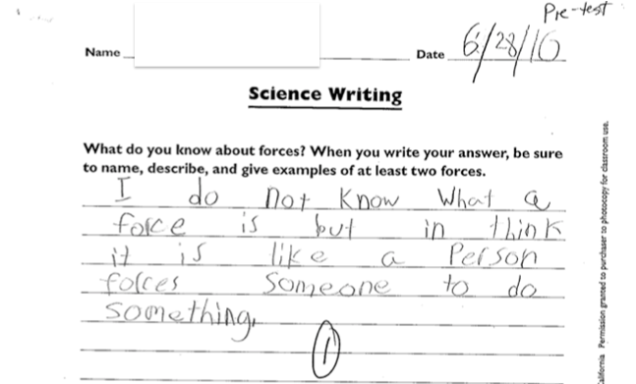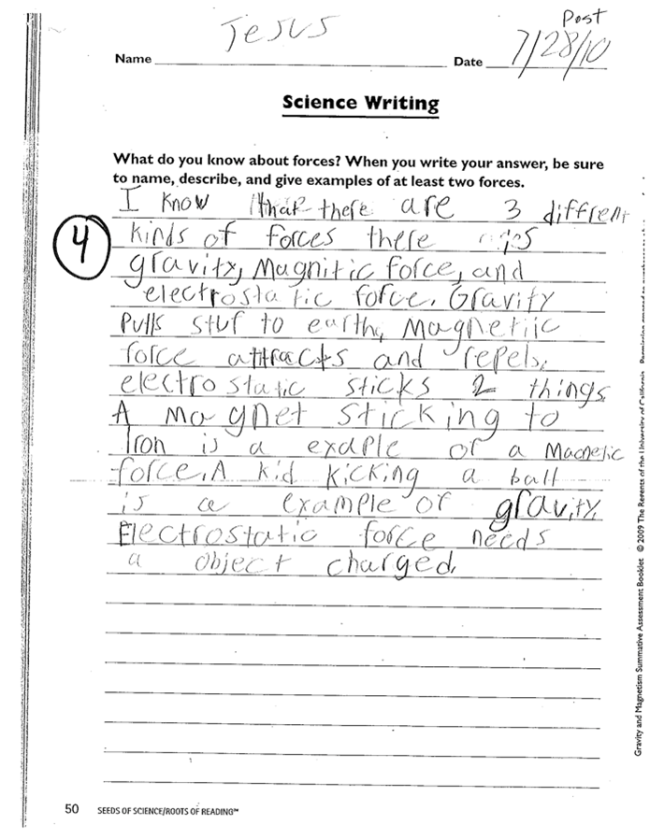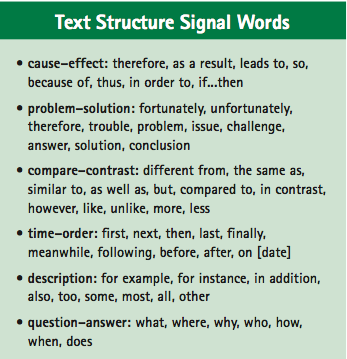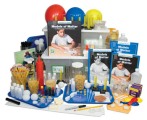Summer School
Summer school can have a profound, positive effect on student learning. Minneapolis Public Schools use several of our Seeds of Science/Roots of Reading® units in their summer school program. They see the positive results: students actively engaged in learning both science content and literacy skills. Science can motivate and inspire reluctant readers to engage with texts the way scientists do, providing a purpose and context for reading and writing. When students read, write and communicate about something they’re interested and engaged in, they’re more likely to stick with it, work hard, and make gains; what literacy experts call the “productive struggle.”
Here’s an example of student work from a short pretest at the beginning of the summer school session:
You can see that this struggling reader/writer in grade 3 has an everyday understanding of the word force, not a scientific understanding.
After a four-week immersion in the Gravity and Magnetism unit from the Seeds of Science/Roots of Reading program, this young scientist developed a much more comprehensive understanding of force as a scientific concept:
We’re proud of the hard work these Minneapolis students (and their teachers) put in over the summer and the learning gains they made. This summer school implementation is inspiring more science-focused summer school programs across the country and we hope this immersion into the role of scientists encourages these students to choose STEM career paths!
13 Guidelines for Teaching About Posing Investigation Questions
Posing investigation questions is the foundation for learning about the natural world, and posing questions that can be investigated is an important part of scientists’ work.
This article provides guidelines that can be used to teach about posing investigation questions related to the content in many science texts. Posing an investigation involves multiple steps, including asking a question, making predictions, planning the investigation, and observing what happens. Understanding how to come up with a question to guide scientific investigation is an important inquiry skill.
When students are taught how to pose their own investigation questions, they can better understand the ways in which scientists explore the natural world and generate new knowledge.
Here are Guidelines for Investigation Questions you can provide students:
Below are 13 Guidelines for Teaching About Posing Investigation Questions related to the content in many science texts:
- Select a text about a science topic that students could potentially investigate in the classroom. Topics could include plant growth, magnets, simple chemical reactions, phase change, or rocks and minerals. Texts about particular scientific investigations can also be used for this purpose, but it is not necessary that the text specifically mention investigations.
- Create a chart on the board listing guidelines for developing investigation questions. See the box above for sample.
- Explain to the class that (more…)
Scientific Evidence and Secrets of the Stomach: A Fun Lesson for Students
 To uncover a secret, scientists look for evidence. Long ago, scientists investigated to find out how the stomach works. The scientists did some surprising things. One investigated digestion by collecting stomach juices from a man with a hole leading to his stomach! The scientists did all of these things to find evidence about how the stomach breaks down food.
To uncover a secret, scientists look for evidence. Long ago, scientists investigated to find out how the stomach works. The scientists did some surprising things. One investigated digestion by collecting stomach juices from a man with a hole leading to his stomach! The scientists did all of these things to find evidence about how the stomach breaks down food.
In the Seeds of Science/Roots of Reading® student book Secrets of the Stomach, the work of three scientists who investigated how the stomach digests food is described. It outlines how each of them found evidence that added to the scientific community’s understanding of digestion. By sharing one of the investigations from this book, you can help students learn that scientists base their explanations on evidence. After hearing the story, students learn that acid juices in the stomach aid in the digestion of food.
Students learn:
- Science investigations begin with a question.
- The stomach is a bag-like structure that holds food.
- The stomach mixes food up and breaks it down with acid.
Beaumont Gets the Inside Story
Share this amazing story with your students. They will be fascinated to hear of a man who had
11 Guidelines for Teaching with Discourse Circles
Discourse circles involve students in structured, evidence-based conversations around challenging statements. This article provides guidelines that can be used to conduct a discourse circle in conjunction with many science texts.
Here is a quick overview of how the discourse circle will work:
11 Guidelines for Teaching with Discourse Circles
- Select a text that provides evidence both for and against a statement. In science, good choices include books about human impact on the environment, books that mention scientific debates, and books about the history of science.
- Craft a statement for which students can find evidence to both support and contradict it. Write the statement on a Preparing for a Discourse Circle copymaster (PDF sample below) and make a copy for each student. The following are some guidelines to use when writing discourse-circle statements:
∙ The text must provide evidence both for and against the statement.
∙ The statement should not be obviously true or obviously false.
∙ Students should be able to choose either position without developing misconceptions about the topic.
∙ The statement should relate to important concepts in the text.Here are two examples of discourse-circle statements:
Students like us can help prevent oil from spilling in the ocean.
The stomach is the most important organ in the digestive system. - Make a class chart titled “Discourse-Circle Directions” that lists the directions for a discourse circle. (See the box above.) (more…)
Teaching Text Structure: Help Students Identify Signal Words
Text structure refers to the ways that authors organize information in a text. For example, some texts are organized as a chronological sequence of events, while others compare two or more things. Teaching students to recognize the underlying structure of content-area texts can help students focus attention on key concepts and relationships, anticipate what’s to come, and monitor their comprehension as they read.
Students can learn to identify a text’s structure by paying attention to signal words. Signal words link ideas together, show relationships, and indicate transitions from one idea to the next. Each text structure is associated with different signal words (see graphic below). Text structure can also be taught using graphic organizers, which visually represent the relationship among key ideas. Graphic organizers can be particularly helpful for English language learners and struggling readers who can use these visual tools to help understand and organize information.
Guidelines for Teaching Text Structure
- Select an appropriate text. Note that some texts may utilize more than one text structure. When introducing text structure, select a text (or portion of a text) that has one easily identifiable text structure. (more…)
Forms of Energy: Everyday Examples to Help Students
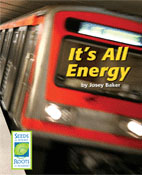 Help students understand energy and its various forms with everyday examples. Students can learn about electrical, motion, sound, thermal, light, and chemical energy with the situations and processes they experience in everyday life. You can finish the lesson with a printable student sheet that reinforces what the students have learned.
Help students understand energy and its various forms with everyday examples. Students can learn about electrical, motion, sound, thermal, light, and chemical energy with the situations and processes they experience in everyday life. You can finish the lesson with a printable student sheet that reinforces what the students have learned.
In the Seeds of Science/Roots of Reading® book It’s All Energy, students read about the many different forms of energy we use every day—to move, talk, cook, create music, light or heat. Below are some examples form the book that you can use with your class to help them understand various forms of energy. Start with a brief description of energy.
What Is Energy?
Energy makes things happen. Every time something moves, it is because of energy. Every time something gets warmer, it is because of energy. Every time something makes a noise, it is because of energy. People use energy to talk, run, and think. In fact, every time we do anything, we use energy!
There are different forms of energy:
- electrical
- motion
- sound
- thermal
- light
- chemical
Electrical Energy
A bolt of lightening is electrical energy. This is the same kind energy used by (more…)
Systems: Teach Students How Parts Interact to Create a Whole
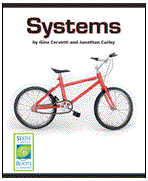 A bicycle is an example of a system that students can think about to understand the the meaning of the words function and system. The information provided below gives students an overview of a system as it relates to a bicycle. Students can then use the Daily Written Reflection worksheet to reinforce what they’ve learned. This worksheet is used as part of the Seeds of Science/Roots of Reading® unit Digestion and Body Systems which uses a student book called Systems. The activity below provides the content you need from this unit to bring this activity into your classroom.
A bicycle is an example of a system that students can think about to understand the the meaning of the words function and system. The information provided below gives students an overview of a system as it relates to a bicycle. Students can then use the Daily Written Reflection worksheet to reinforce what they’ve learned. This worksheet is used as part of the Seeds of Science/Roots of Reading® unit Digestion and Body Systems which uses a student book called Systems. The activity below provides the content you need from this unit to bring this activity into your classroom.
What Makes a Wheel a Wheel
Think about a bicycle wheel. Have you ever thought about why a wheel is the way it is? It’s the structure of a wheel – the way the wheel is shaped and built – that makes it a wheel. The wheel is long and has long, thin spokes crossing in the middle. The spokes keep the wheel from bending out of shape.
Why is the structure of the wheel important? Its structure has to do with its function – what it does or what it is used for. The function of this wheel is to roll so that the bicycle can move forward. What if the wheel had a different structure. Could it still do its function? Could the wheel roll if it were shaped like a square? What if the wheel were floppy like a noodle?
A Wheel Is Just One Part of a Bicycle.
A bicycle is made up of lots of parts. One bike could have more than 100 different parts. Each part of a bicycle has a function and a structure that helps the part perform its function well. Of course, bike parts don’t do much good unless they are all put together to make a bicycle. You can’t ride just a wheel! A bicycle with all its parts connected is a system.
A system is a group of parts that interact, or work together. When the pedals on a bicycle move, they turn the gear. When the gear turns, it moves (more…)
Introduce Students to Concepts About Shorelines and Beaches
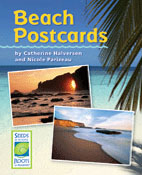 Most students have heard the terms “beach” and “shoreline,” but do they know the difference?
Most students have heard the terms “beach” and “shoreline,” but do they know the difference?
Here are some important concepts for students:
- a shoreline is a place where water meets land
- a beach is a shoreline where people can walk near the water
- beaches are covered with loose material
- beaches can be rocky, sandy, or covered with coral or beach wrack
In the Seeds of Science/Roots of Reading® book Beach Postcards, students can read an account of a girl named Jo, who visits beaches around the world with her family, and sends postcards back to her friend Linn. Linn writes a report about what she learned about beaches and shorelines from Jo’s postcard. In addition to conveying the concepts bulleted above, the book is also designed to help students who may have limited knowledge of shorelines to imagine the experience of being at various beaches.
Below are some questions you can pose using content taken from the book.
How is a beach different from some kinds of shorelines?
Explain that the place where water meets the land is called a shoreline. There are many kinds of shorelines all around the world.
Beaches are one kind of shoreline. Beaches are shorelines where people can walk beside the water. Beaches are covered with loose material like rocks or sand. Beaches can form along lakes, rivers, and the ocean.
What do you think you would see if you were standing on a rocky beach? What would you feel? What would you wear to visit this beach?
Explain that rocky beaches are covered with rocks and pebbles. Some of the rocks are big. The pebbles are small.
Rocks and pebbles get to the beach in many ways. Rocks can fall onto the beach from cliffs. Rocks on the beach can break and become pebbles. Rocks and pebbles can be carried to the beach by waves or rivers. There may be (more…)
